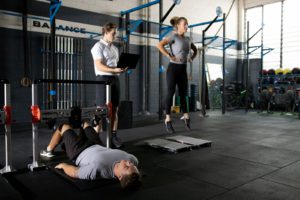RESEARCH SUMMARY: Fitness tests and occupational tasks of military interest (Hauschild et al., 2016)
Original research title: Fitness tests and occupational tasks of military interest: A systematic review of correlations
Authors: Hauschild V, DeGroot DW, Hall S, Grier T, Deaver KD, Hauret KG, & Jones BH
Year: 2016
Purpose
Physically demanding occupations (e.g., military, firefighting, law enforcement) use fitness tests to guide personnel selection. Unfortunately, the relationship between physical test results and job performance is often poor as the tests do not represent the physical job requirements. Consequently, results of physical fitness tests can be poor predictors of job performance.
This review examines the literature to determine the relationship between physical fitness test results and job performance. Moreover, the review seeks to understand if any of the tests consistently correlated with job performance.
Methods
A comprehensive review of the literature for original studies that provided Pearson correlation coefficients between physical fitness tests and performance outcomes in military, firefighter, and / or law enforcement populations. From an initial search yield of 17,404 studies, 27 were included in the final meta-analysis.
Primary health-related fitness components were grouped into cardiorespiratory endurance, muscular strength, muscular endurance, and flexibility. Muscular strength and endurance were further grouped by upper or lower body. 12 common occupational tasks were selected as job-specific outcomes, including lift and lower, lift and carry, push-pull, dig, climb, crawl, and others.
Key findings
- Lower and upper body strength had moderate and strong correlations across 7 of the 12 occupational tasks. This suggests that individuals with higher strength generally performed better on occupational tasks compared to individuals with lower strength. The most common type of lower body strength assessment was the vertical jump and standing broad jump, probably because they are easy to administer in the field.
- Repeated push-up, and lift and lower tests were the most common upper body strength and endurance assessments. To maximize the value of testing, practitioners should also consider measuring how personnel complete the test (i.e., outcome) and not only the result (i.e., output).
VALD’s solution
VALD has a suite of systems that can match your specific needs. This includes ForceDecks Dual Force Plate System, NordBord Hamstring Testing System, ForceFrame Strength Testing System, AirBands Blood Flow Restriction (BFR) Cuffs, HumanTrak Movement Analysis System and TeleHab Exercise Prescription App.
Data from VALD Systems integrate with VALD Hub to create a simple workflow for testing and understanding who is underperforming. Importantly, VALD’s testing, and data analysis solutions help practitioners measure the neuromuscular deficits causing poor performance.
Additionally, VALD’s systems identify who is performing poorly so interventions can be targeted to correct the underlying deficit:
- Create a sequence of tests to assess the lower and upper body strength of your personnel and understand their job readiness.
- Modify the test sequence to match specific job role requirements and use the power of normative data to identify who is below average.
For the full study, see here.
Would you like to learn more about VALD Tactical Systems?
Contact us at info@valdtactical.com or fill in the contact form here.













